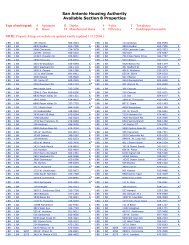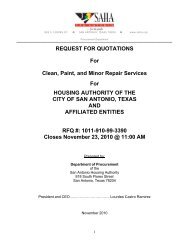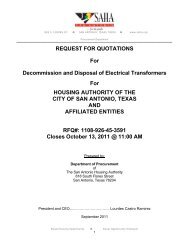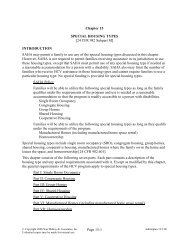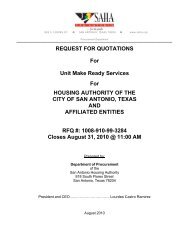- Page 1 and 2: ADMINISTRATIVE PLANFOR THESECTION 8
- Page 3 and 4: Administrative Plan -Table of Conte
- Page 5 and 6: Administrative Plan -Table of Conte
- Page 7 and 8: Administrative Plan -Table of Conte
- Page 9 and 10: Administrative Plan -Table of Conte
- Page 11 and 12: Administrative Plan -Table of Conte
- Page 13 and 14: Administrative Plan -Table of Conte
- Page 15 and 16: Administrative Plan -Table of Conte
- Page 17 and 18: Administrative Plan -Table of Conte
- Page 19 and 20: Administrative Plan -Table of Conte
- Page 21 and 22: Administrative Plan -Table of Conte
- Page 23 and 24: Administrative Plan -Table of Conte
- Page 25 and 26: Administrative Plan -Table of Conte
- Page 27 and 28: Administrative Plan -Table of Conte
- Page 29 and 30: Administrative Plan -Table of Conte
- Page 31 and 32: 1-I.A. OVERVIEWPART I: THE PHAThis
- Page 33: 1-I.E. THE PHA’S COMMITMENT TO ET
- Page 37 and 38: What does HUD do?HUD has the follow
- Page 39 and 40: 1-II.D. APPLICABLE REGULATIONSAppli
- Page 41 and 42: Occupancy policies, including defin
- Page 43 and 44: Chapter 2FAIR HOUSING AND EQUAL OPP
- Page 45 and 46: The PHA will not use any of these f
- Page 47 and 48: PART II: POLICIES RELATED TO PERSON
- Page 49 and 50: 2-II.C. REQUEST FOR AN ACCOMMODATIO
- Page 51 and 52: Requests for accommodations must be
- Page 53 and 54: The Americans with Disabilities Act
- Page 55 and 56: PART III: IMPROVING ACCESS TO SERVI
- Page 57 and 58: y LEP persons to the PHA’s Housin
- Page 59 and 60: The HUD definition of a person with
- Page 61 and 62: PART I: DEFINITIONS OF FAMILY AND H
- Page 63 and 64: Remaining Member of a Tenant Family
- Page 65 and 66: 3-I.I. PERSONS WITH DISABILITIES AN
- Page 67 and 68: 3-I.L. ABSENT FAMILY MEMBERSIndivid
- Page 69 and 70: Absence of Entire FamilyPHA PolicyT
- Page 71 and 72: 3-I.M. LIVE-IN AIDEThe definition o
- Page 73 and 74: Using Income Limits for Eligibility
- Page 75 and 76: Eligible NoncitizensIn addition to
- Page 77 and 78: 3-II.E. STUDENTS ENROLLED IN INSTIT
- Page 80 and 81: PART III: DENIAL OF ADMISSION3-III.
- Page 82 and 83: If any applicant household member d
- Page 84 and 85:
Previous Behavior in Assisted Housi
- Page 86 and 87:
HUD requires the PHA to provide pro
- Page 88 and 89:
PHA PolicyAs a condition of receivi
- Page 90 and 91:
The term stalking means:- To follow
- Page 92 and 93:
or the extension period has elapsed
- Page 94 and 95:
Has a physical, mental, or emotiona
- Page 96 and 97:
EXHIBIT 3-2: DEFINITION OF INSTITUT
- Page 98 and 99:
(ii) In the case of a veterinary sc
- Page 100 and 101:
(b) Proprietary institution of high
- Page 102 and 103:
4-I.A. OVERVIEWPART I: THE APPLICAT
- Page 104 and 105:
4-I.D. PLACEMENT ON THE WAITING LIS
- Page 106 and 107:
4-II.C. OPENING AND CLOSING THE WAI
- Page 108 and 109:
4-II.F. UPDATING THE WAITING LIST [
- Page 110 and 111:
PART III: SELECTION FOR HCV ASSISTA
- Page 112 and 113:
Involuntary Displacement Preference
- Page 114 and 115:
4-III.D. NOTIFICATION OF SELECTIONW
- Page 116 and 117:
Chapter 5BRIEFINGS AND VOUCHER ISSU
- Page 118 and 119:
Oral Briefing [24 CFR 982.301(a)]Ea
- Page 120 and 121:
5-I.C. FAMILY OBLIGATIONSObligation
- Page 122 and 123:
The family must notify the PHA with
- Page 124 and 125:
Single person families will be allo
- Page 126 and 127:
PHA PolicyVouchers will be issued t
- Page 128 and 129:
PHA’s determination not to suspen
- Page 130 and 131:
6-I.A. OVERVIEWPART I: ANNUAL INCOM
- Page 132 and 133:
PHA PolicyIf the family includes a
- Page 134 and 135:
PHAs are required to use HUD’s En
- Page 136 and 137:
Income Earned under Certain Federal
- Page 138 and 139:
6-I.E. EARNED INCOME DISALLOWANCE F
- Page 140 and 141:
6-I.F. BUSINESS INCOME [24 CFR 5.60
- Page 142 and 143:
6-I.G. ASSETS [24 CFR 5.609(b)(3) a
- Page 144 and 145:
Jointly Owned AssetsThe regulation
- Page 146 and 147:
Equity in Real Property or Other Ca
- Page 148 and 149:
Personal PropertyPersonal property
- Page 150 and 151:
Periodic Payments Excluded from Ann
- Page 152 and 153:
6-I.K. PERIODIC AND DETERMINABLE AL
- Page 154 and 155:
6-I.M. ADDITIONAL EXCLUSIONS FROM A
- Page 156 and 157:
6-II.A. INTRODUCTIONPART II: ADJUST
- Page 158 and 159:
Summary of Allowable Medical Expens
- Page 160 and 161:
Eligible Attendant CareThe family d
- Page 162 and 163:
Furthering EducationPHA PolicyIf th
- Page 164 and 165:
PART III: CALCULATING FAMILY SHARE
- Page 166 and 167:
HUD-Defined Financial HardshipFinan
- Page 168 and 169:
Temporary HardshipIf the PHA determ
- Page 170 and 171:
Step 3: At the second regular reexa
- Page 172 and 173:
EXHIBIT 6-1: ANNUAL INCOME INCLUSIO
- Page 174 and 175:
(3) Except where excluded under par
- Page 176 and 177:
(11) Earnings in excess of $480 for
- Page 178 and 179:
EXHIBIT 6-3: TREATMENT OF FAMILY AS
- Page 180 and 181:
(2) Second twelve-month exclusion a
- Page 182 and 183:
(4) The amount of the imputed welfa
- Page 184 and 185:
PART I: GENERAL VERIFICATION REQUIR
- Page 186 and 187:
MTW Program ParticipantsAny documen
- Page 188 and 189:
TID reports will be retained in par
- Page 190 and 191:
When Third-Party Verification is No
- Page 192 and 193:
PART II: VERIFYING FAMILY INFORMATI
- Page 194 and 195:
Separation or DivorcePHA PolicyCert
- Page 196 and 197:
Independent StudentPHA PolicyThe PH
- Page 198 and 199:
7-II.G. CITIZENSHIP OR ELIGIBLE IMM
- Page 200 and 201:
PART III: VERIFYING INCOME AND ASSE
- Page 202 and 203:
7-III.E. ASSETS AND INCOME FROM ASS
- Page 204 and 205:
7-III.J. STUDENT FINANCIAL ASSISTAN
- Page 206 and 207:
PART IV: VERIFYING MANDATORY DEDUCT
- Page 208 and 209:
7-IV.C. DISABILITY ASSISTANCE EXPEN
- Page 210 and 211:
Unreimbursed ExpenseTo be eligible
- Page 212 and 213:
Applicable to Non-MTW Program Appli
- Page 214 and 215:
© Copyright 2008 Nan McKay & Assoc
- Page 216 and 217:
EXHIBIT 7-2: SUMMARY OF DOCUMENTATI
- Page 218 and 219:
8.I.A. GENERAL HUD REQUIREMENTSPART
- Page 220 and 221:
The PHA must define a “healthy li
- Page 222 and 223:
Lack of security for the unitNo uti
- Page 224 and 225:
PART II: THE INSPECTION PROCESS8-II
- Page 226 and 227:
PHA PolicyIf any HQS violations are
- Page 228 and 229:
inspections independently of routin
- Page 230 and 231:
If an owner fails to correct HQS de
- Page 232 and 233:
The PHA must make a rent reasonable
- Page 234 and 235:
8-III.D . PHA RENT REASONABLENESS M
- Page 236 and 237:
Interior Air QualityThe dwelling un
- Page 238 and 239:
EXHIBIT 8-2: SUMMARY OF TENANT PREF
- Page 240 and 241:
Chapter 9GENERAL LEASING POLICIESIN
- Page 242 and 243:
The owner and the family must submi
- Page 244 and 245:
PHA-Owned Units [24 CFR 982.352(b)]
- Page 246 and 247:
The tenant must have legal capacity
- Page 248 and 249:
items, appliances or services canno
- Page 250 and 251:
Corrections to the RTA will be acce
- Page 252 and 253:
9-I.H. CHANGES IN LEASE OR RENT [24
- Page 254 and 255:
PART I. MOVING WITH CONTINUED ASSIS
- Page 256 and 257:
Restrictions on Elective Moves [24
- Page 258 and 259:
PART II: PORTABILITY10-II.A. OVERVI
- Page 260 and 261:
Reexamination of Family Income and
- Page 262 and 263:
Sending Documentation to the Receiv
- Page 264 and 265:
Outside the Receiving PHA’s Juris
- Page 266 and 267:
MTW Program ParticipantsThe timefra
- Page 268 and 269:
Ongoing Notification Responsibiliti
- Page 270 and 271:
Absorbing a Portable FamilyThe rece
- Page 272 and 273:
PART I: ANNUAL REEXAMINATIONS [24 C
- Page 274 and 275:
Social security numbers (See Chapte
- Page 276 and 277:
PART II: INTERIM REEXAMINATIONS [24
- Page 278 and 279:
Joint Custody of DependentsPHA Poli
- Page 280 and 281:
11-II.C. CHANGES AFFECTING INCOME O
- Page 282 and 283:
Effective DatesThe PHA must establi
- Page 284 and 285:
Subsidy Standards [24 CFR 982.505(c
- Page 286 and 287:
Chapter 12TERMINATION OF ASSISTANCE
- Page 288 and 289:
PHA PolicyA family will be consider
- Page 290 and 291:
The PHA will consider all credible
- Page 292 and 293:
In making its decision to terminate
- Page 294 and 295:
12-II.D. CRITERIA FOR DECIDING TO T
- Page 296 and 297:
If the tenant wishes to contest the
- Page 298 and 299:
12-II.F. TERMINATION NOTICE [HCV GB
- Page 300 and 301:
PART III: TERMINATION OF TENANCY BY
- Page 302 and 303:
After the initial lease term, “ot
- Page 304 and 305:
EXHIBIT 12-1: STATEMENT OF FAMILY O
- Page 306 and 307:
Members of the household must not e
- Page 308 and 309:
PART I. OWNERS IN THE HCV PROGRAM13
- Page 310 and 311:
The selected unit must meet HUD’s
- Page 312 and 313:
HUD may waive the conflict of inter
- Page 314 and 315:
Legal Ownership of UnitThe followin
- Page 316 and 317:
Part B is the body of the contract.
- Page 318 and 319:
Late HAP Payments [24 CFR 982.451(a
- Page 320 and 321:
13-II.E. HAP CONTRACT TERM AND TERM
- Page 322 and 323:
EXHIBIT 13-1: SUMMARY OF REQUIREMEN
- Page 324 and 325:
PART I: PREVENTING, DETECTING, ANDI
- Page 326 and 327:
14-I.C. INVESTIGATING ERRORS AND PR
- Page 328 and 329:
PART II: CORRECTIVE MEASURES AND PE
- Page 330 and 331:
Penalties for Program AbuseIn the c
- Page 332 and 333:
Repayment to the PHANeither a famil
- Page 334 and 335:
Chapter 15SPECIAL HOUSING TYPES[24
- Page 336 and 337:
Sanitary Facilities: At least one f
- Page 338 and 339:
PART III. GROUP HOME[24 CFR 982.610
- Page 340 and 341:
15-IV.I. OVERVIEWPART IV. SHARED HO
- Page 342 and 343:
PART V. COOPERATIVE HOUSING[24 CFR
- Page 344 and 345:
Utility AllowanceThe PHA must estab
- Page 346 and 347:
The family must meet the Federal mi
- Page 348 and 349:
15-VII.D. ELIGIBLE UNITS [24 CFR 98
- Page 350 and 351:
How to obtain homeownership financi
- Page 352 and 353:
Provide that the purchaser is not o
- Page 354 and 355:
Has an ownership interest in the un
- Page 356 and 357:
PHA PolicyThe PHA’s housing assis
- Page 358 and 359:
15-VII.O. MORTGAGE DEFAULT [24 CFR
- Page 360 and 361:
PART I: ADMINISTRATIVE FEE RESERVE
- Page 362 and 363:
Updating Payment StandardsWhen HUD
- Page 364 and 365:
"Success Rate" Payment Standard Amo
- Page 366 and 367:
PART III: INFORMAL REVIEWS AND HEAR
- Page 368 and 369:
Informal Review Decision [24 CFR 98
- Page 370 and 371:
Informal Hearing ProceduresNotice t
- Page 372 and 373:
Pre-Hearing Right to Discovery [24
- Page 374 and 375:
Explain the rules of conducting the
- Page 376 and 377:
Background: A brief, impartial stat
- Page 378 and 379:
Notice of Denial or Termination of
- Page 380 and 381:
Recording of the HearingThe family
- Page 382 and 383:
Informal Complaints by Applicants a
- Page 384 and 385:
Family Debts to the PHAPHA PolicyA
- Page 386 and 387:
Collection of Housing Assistance Ov
- Page 388 and 389:
HUD Verification MethodSeveral of t
- Page 390 and 391:
Indicator 9: Annual reexaminationsM
- Page 392 and 393:
PART VI: RECORD KEEPING16-VI.A. OVE
- Page 394 and 395:
Criminal RecordsThe PHA may only di
- Page 396 and 397:
PART VIII: DETERMINATION OF INSUFFI
- Page 398 and 399:
16-IX.A. NOTIFICATION TO PARTICIPAN
- Page 400 and 401:
Proving that You Are a Victim of Do
- Page 402 and 403:
EXHIBIT 16-2: SAMPLE NOTICE TO HOUS
- Page 404 and 405:
DefinitionsFor purposes of determin
- Page 406 and 407:
PART I: DISCLOSURE17-I.A. SOCIAL SE
- Page 408 and 409:
PART II: DOCUMENTATION17-II.A. SOCI
- Page 410 and 411:
17-III.B. INDIVIDUALS WITHOUT AN AS
- Page 412 and 413:
17-III.E. THIRD PARTY VERIFICATION
- Page 414 and 415:
17-III.H. ENSURING THE AVAILABILITY
- Page 416 and 417:
EXHIBIT 17-2: EXCERPT FROM HUD VERI
- Page 418 and 419:
Failed Verification Report Error Me
- Page 420:
Chapter 18PROJECT-BASED VOUCHERSINT
- Page 423 and 424:
PART II: PBV OWNER PROPOSALS18-II.A
- Page 425 and 426:
Alternatively, the PHA may accept p
- Page 427 and 428:
Ineligible Housing Types [24 CFR 98
- Page 429 and 430:
Exceptions are allowed and PBV unit
- Page 431 and 432:
18-II.G. SITE SELECTION STANDARDSCo
- Page 433 and 434:
The PHA activities under the PBV pr
- Page 435 and 436:
The PHA must inspect each contract
- Page 437 and 438:
layering review is completed. Likew
- Page 439 and 440:
The PHA must enter into a HAP contr
- Page 441 and 442:
Remedies for HQS Violations [24 CFR
- Page 443 and 444:
edecoration must be in accordance w
- Page 445 and 446:
a separate waiting list for PBV ass
- Page 447 and 448:
Persons with Limited English Profic
- Page 449 and 450:
18-VII.B. LEASE [24 CFR 983.256]The
- Page 451 and 452:
The owner may collect a security de
- Page 453 and 454:
Specifically made available for eld
- Page 455 and 456:
of Area Median Gross Income (AMGI),
- Page 457 and 458:
18-VIII.C. REASONABLE RENT [24 CFR
- Page 459 and 460:
PART IX: PAYMENTS TO OWNER18-IX.A.
- Page 461 and 462:
18-IX.D. OTHER FEES AND CHARGES [24
- Page 463 and 464:
MSAMTCSNOFAOMBPASSPHAPHRAPICPIHMetr
- Page 465 and 466:
Budget authority. An amount authori
- Page 467 and 468:
Drug-related criminal activity. As
- Page 469 and 470:
Housing assistance payment. The mon
- Page 471 and 472:
Monthly income. One twelfth of annu
- Page 473 and 474:
Rent to owner. The total monthly re
- Page 475:
Utility allowance. If the cost of u




